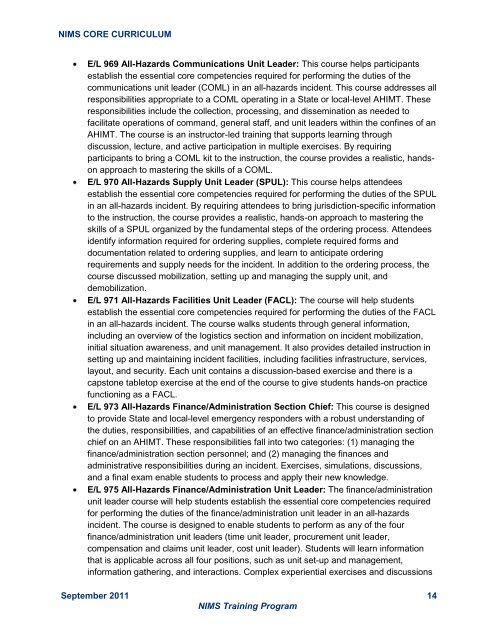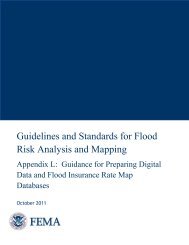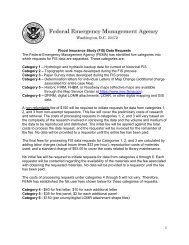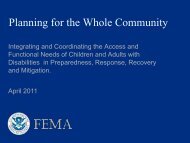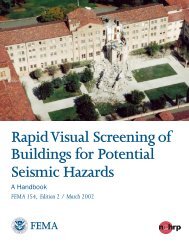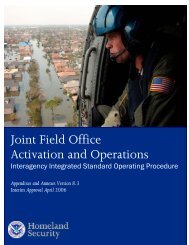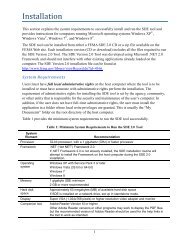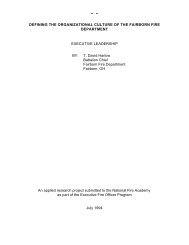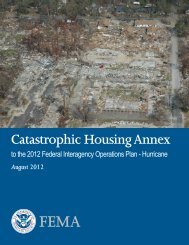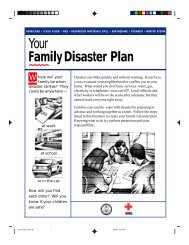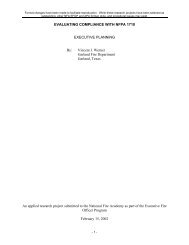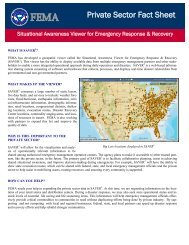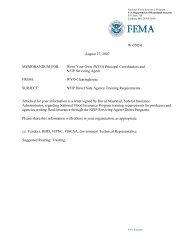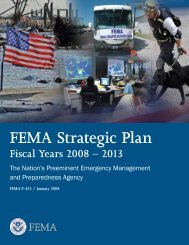NIMS Training Program - Federal Emergency Management Agency
NIMS Training Program - Federal Emergency Management Agency
NIMS Training Program - Federal Emergency Management Agency
Create successful ePaper yourself
Turn your PDF publications into a flip-book with our unique Google optimized e-Paper software.
<strong>NIMS</strong> CORE CURRICULUM<br />
E/L 969 All-Hazards Communications Unit Leader: This course helps participants<br />
establish the essential core competencies required for performing the duties of the<br />
communications unit leader (COML) in an all-hazards incident. This course addresses all<br />
responsibilities appropriate to a COML operating in a State or local-level AHIMT. These<br />
responsibilities include the collection, processing, and dissemination as needed to<br />
facilitate operations of command, general staff, and unit leaders within the confines of an<br />
AHIMT. The course is an instructor-led training that supports learning through<br />
discussion, lecture, and active participation in multiple exercises. By requiring<br />
participants to bring a COML kit to the instruction, the course provides a realistic, handson<br />
approach to mastering the skills of a COML.<br />
E/L 970 All-Hazards Supply Unit Leader (SPUL): This course helps attendees<br />
establish the essential core competencies required for performing the duties of the SPUL<br />
in an all-hazards incident. By requiring attendees to bring jurisdiction-specific information<br />
to the instruction, the course provides a realistic, hands-on approach to mastering the<br />
skills of a SPUL organized by the fundamental steps of the ordering process. Attendees<br />
identify information required for ordering supplies, complete required forms and<br />
documentation related to ordering supplies, and learn to anticipate ordering<br />
requirements and supply needs for the incident. In addition to the ordering process, the<br />
course discussed mobilization, setting up and managing the supply unit, and<br />
demobilization.<br />
E/L 971 All-Hazards Facilities Unit Leader (FACL): The course will help students<br />
establish the essential core competencies required for performing the duties of the FACL<br />
in an all-hazards incident. The course walks students through general information,<br />
including an overview of the logistics section and information on incident mobilization,<br />
initial situation awareness, and unit management. It also provides detailed instruction in<br />
setting up and maintaining incident facilities, including facilities infrastructure, services,<br />
layout, and security. Each unit contains a discussion-based exercise and there is a<br />
capstone tabletop exercise at the end of the course to give students hands-on practice<br />
functioning as a FACL.<br />
E/L 973 All-Hazards Finance/Administration Section Chief: This course is designed<br />
to provide State and local-level emergency responders with a robust understanding of<br />
the duties, responsibilities, and capabilities of an effective finance/administration section<br />
chief on an AHIMT. These responsibilities fall into two categories: (1) managing the<br />
finance/administration section personnel; and (2) managing the finances and<br />
administrative responsibilities during an incident. Exercises, simulations, discussions,<br />
and a final exam enable students to process and apply their new knowledge.<br />
E/L 975 All-Hazards Finance/Administration Unit Leader: The finance/administration<br />
unit leader course will help students establish the essential core competencies required<br />
for performing the duties of the finance/administration unit leader in an all-hazards<br />
incident. The course is designed to enable students to perform as any of the four<br />
finance/administration unit leaders (time unit leader, procurement unit leader,<br />
compensation and claims unit leader, cost unit leader). Students will learn information<br />
that is applicable across all four positions, such as unit set-up and management,<br />
information gathering, and interactions. Complex experiential exercises and discussions<br />
September 2011 14<br />
<strong>NIMS</strong> <strong>Training</strong> <strong>Program</strong>


